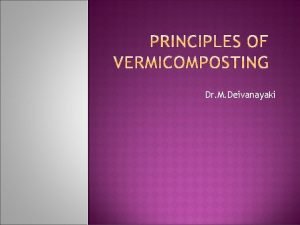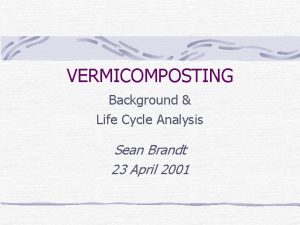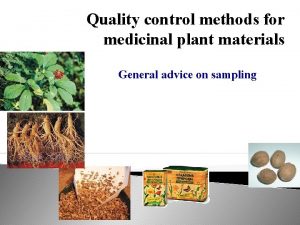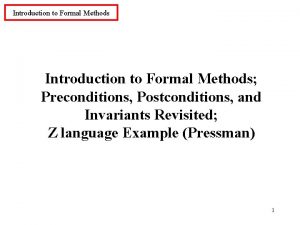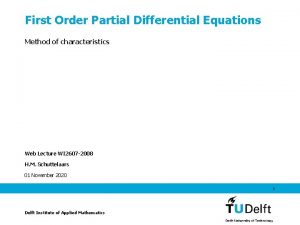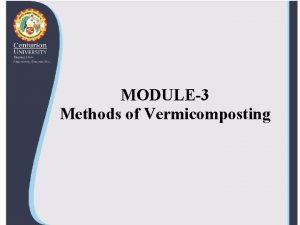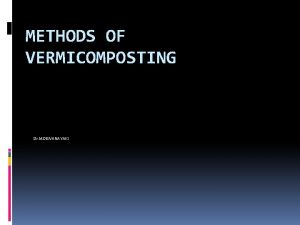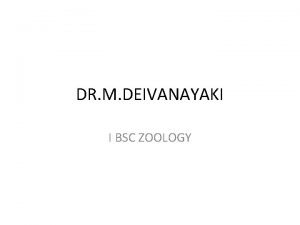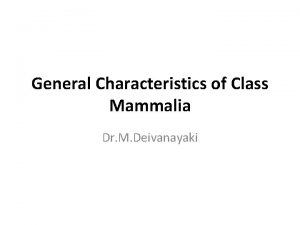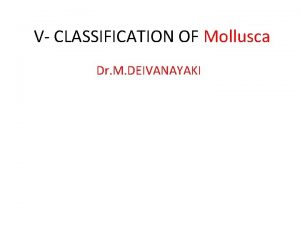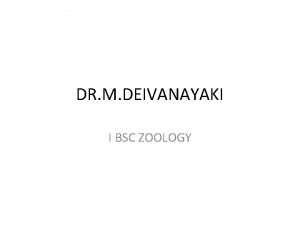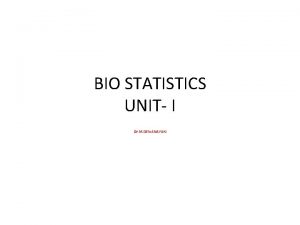METHODS OF VERMICOMPOSTING Dr M DEIVANAYAKI What is











- Slides: 11

METHODS OF VERMICOMPOSTING Dr. M. DEIVANAYAKI

What is vermitechnology It is a process of composting organic wastes into valuable organic fertilizer by the action of earthworms

Vermicompost and vermicast VERMICOMPOST: This compost is an odorless, clean, organic material containing adequate quantities of N, P, K and several micronutrients essential for plant growth. VERMICAST: It is also called worm castings, worm humus, worm manure, or worm faeces is the endproduct of the breakdown of organic matter by earthworms

METHODS OF VERMICOMPOSTING Methods of Vermicomposting (1) Pits below the ground Pits made for vermicomposting are 1 m deep and 1. 5 m wide. The length varies as required. (2) Heaping above the ground The waste material is spread on a polythene sheet placed on the ground and then covered with cattle dung. The efficacy of pit and heap methods of preparing vermicompost under field conditions was compared [8]. Considering the biodegradation of wastes as the criterion, the heap method of preparing vermicompost was better than the pit method. Earthworm population was high in the heap method, with a 21 -fold increase in Eudrilus eugeniae as compared to 17 fold increase in the pit method. Biomass production was also higher in the heap method (46 -fold increase) than in the pit method (31 -fold). Consequent production of vermicompost was also higher in the heap method (51 kg) than in the pit method (40 kg).

(3) Tanks above the ground Tanks made up of different materials such as normal bricks, hollow bricks, shabaz stones, asbestos sheets and locally available rocks were evaluated for vermicompost preparation. Tanks can be constructed with the dimensions suitable for operations. The tanks with dimensions of 1. 5 m (5 feet) width, 4. 5 m (15 feet) length and 0. 9 m (3 feet) height. The commercial bio-digester contains a partition wall with small holes to facilitate easy movement of earthworms from one tank to the other. (4) Cement rings Vermicompost can also be prepared above the ground by using cement. The size of the cement ring should be 90 cm in diameter and 30 cm in height. The details of preparing vermicompost by this method have been described in a later section. (5) Commercial model The commercial model for vermicomposting consists of four chambers enclosed by a wall (1. 5 m width, 4. 5 m length and 0. 9 m height). The walls are made up of different materials such as normal bricks, hollow bricks, shabaz stones, asbestos sheets and locally available rocks. This model contains partition walls with small holes to facilitate easy movement of earthworms from one chamber to another.


BED METHOD

TANKS ABOVE THE GROUND

CEMENT RING

HEAPING METHOD

 Precautions of vermicomposting
Precautions of vermicomposting Cycle of paper
Cycle of paper Direct wax pattern technique
Direct wax pattern technique Quality control methods for medicinal plant materials
Quality control methods for medicinal plant materials Immobilization methods
Immobilization methods Z formal specification
Z formal specification The drug basket method dispense medication to
The drug basket method dispense medication to Deposit pricing methods
Deposit pricing methods Agile embedded software development
Agile embedded software development Performance appraisal
Performance appraisal Method of characteristics pde second order
Method of characteristics pde second order Clares law campaign methods
Clares law campaign methods
